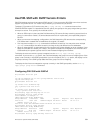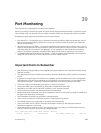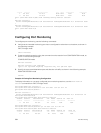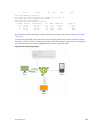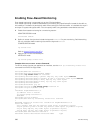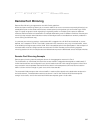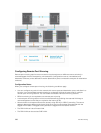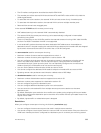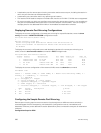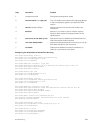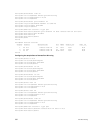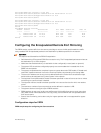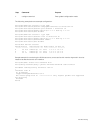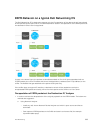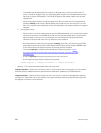• The L3 interface configuration should be blocked for RPM VLAN.
• The member port of the reserved VLAN should have MTU and IPMTU value as MAX+4 (to hold the
VLAN tag parameter).
• To associate with source session, the reserved VLAN can have at max of only 4 member ports.
• To associate with destination session, the reserved VLAN can have multiple member ports.
• Reserved Vlan cannot have untagged ports.
In the reserved L2 VLAN used for remote port mirroring:
• MAC address learning in the reserved VLAN is automatically disabled.
• The reserved VLAN for remote port mirroring can be automatically configured in intermediate
switches by using GVRP.
• There is no restriction on the VLAN IDs used for the reserved remote-mirroring VLAN. Valid VLAN IDs
are from 2 to 4094. The default VLAN ID is not supported.
• In mirrored traffic, packets that have the same destination MAC address as an intermediate or
destination switch in the path used by the reserved VLAN to transport the mirrored traffic are dropped
by the switch that receives the traffic if the switch has a L3 VLAN configured.
In a source session used for remote port mirroring:
• Maximum number of source sessions supported on a switch: 4
• Maximum number of source ports supported in a source session: 128
• You can configure physical ports and port-channels as sources in remote port mirroring and use
them in the same source session. You can use both Layer 2 (configured with the switchport
command) and Layer 3 ports as source ports. You can optionally configure one or more source
VLANs to specify the VLAN traffic to be mirrored on source ports.
• You can use the default VLAN and native VLANs as a source VLAN.
• You cannot configure the dedicated VLAN used to transport mirrored traffic as a source VLAN.
• Egressing remote-vlan packets are rate limited to a default value of 100 Mbps.
In a destination session used for remote port mirroring:
• Maximum number of destination sessions supported on a switch: 64
• Maximum number ports supported in a destination session: 64.
• You can configure any port as a destination port.
• You can configure additional destination ports in an active session.
• You can tunnel the mirrored traffic from multiple remote-port source sessions to the same
destination port.
• By default, destination port sends the mirror traffic to the probe port by stripping off the rpm header.
We can also configure the destination port to send the mirror traffic with the rpm header intact in the
original mirror traffic.
• By default, ingress traffic on a destination port is dropped.
Restrictions
When you configure remote port mirroring, the following restrictions apply:
• You can configure the same source port to be used in multiple source sessions.
• You cannot configure a source port channel or source VLAN in a source session if the port channel or
VLAN has a member port that is configured as a destination port in a remote-port mirroring session.
Port Monitoring
689



